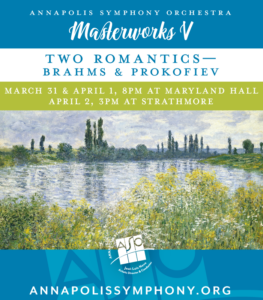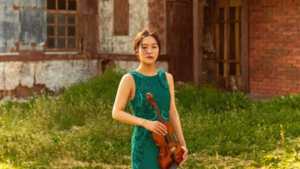Masterworks V
Friday & Saturday, March 31 & April 1 at 8:00 PM at Maryland Hall
Sunday, April 2 at 3:00 PM at Strathmore Music Center
*Single tickets for the Strathmore performance on April 2, 2023 are on sale through Strathmore’s website. Click here to purchase.
Program:
Behzad Ranjbaran Esther
Sergei Prokofiev Concerto for Violin No. 1 in D major, op. 19, Esther Yoo, violin
Johannes Brahms Symphony No. 2 in D major, op. 73

Behzad Ranjbaran Esther
The performance opens with Behzad Ranjbaran’s composition “Esther,” a piece inspired by ancient mysticism, the number seven and themes of bravery, tolerance, conspiracy, and compassion in the ancient Biblical story of the Jewish heroine Esther. Ranjbaran’s music reflects his Persian roots and love of storytelling through music.
Sergei Prokofiev Concerto for Violin No. 1 in D major, op. 19, Esther Yoo, violin
The second piece in the evening’s repertoire features Sergei Prokofiev’s Violin Concerto No. 1 with guest artist Esther Yoo. Envisioned as a modest violin concertino, Prokofiev’s Concerto No. 1 became an important symphonic work in both scope and complexity. Prokofiev combined the harsh dissonances and spiky melodies that scandalized his professors at the Moscow Conservatory with romantic passages of elegant lyricism.
 Esther Yoo began playing the violin at four years old and made her concerto debut aged eight. At sixteen, she became the youngest prizewinner of the International Sibelius Violin Competition and two years later was one of the youngest ever prizewinners of the Queen Elisabeth Competition. In 2014 she became a BBC Radio 3 New Generation Artist, and in 2018 was selected as one of Classic FM’s Top 30 Artists under 30. In 2020 WQXR named her one of twenty Artists to Watch.
Esther Yoo began playing the violin at four years old and made her concerto debut aged eight. At sixteen, she became the youngest prizewinner of the International Sibelius Violin Competition and two years later was one of the youngest ever prizewinners of the Queen Elisabeth Competition. In 2014 she became a BBC Radio 3 New Generation Artist, and in 2018 was selected as one of Classic FM’s Top 30 Artists under 30. In 2020 WQXR named her one of twenty Artists to Watch.
Johannes Brahms Symphony No. 2 in D major, op. 73
We finish the evening with Johannes Brahms’ Symphony No. 2. The D major Symphony by Brahms seems to reflect the composer’s relaxed state of mind during the happy summer of 1877. The lyrical character of the work—sometimes referred to as Brahms’s “Pastoral” Symphony—is remarkably intricate and unified, resulting in a composition that radiates energy and optimism from start to finish.
The symphony’s sunny spirit – especially the last two movements – and relatively transparent orchestration induced one of the composer’s friends to exclaim: “It is all rippling streams, blue sky, sunshine, and cool green shadows.” The premiere in Vienna on December 30th, 1877, under the baton of Hans Richter, was an unqualified success.
Maestro José-Luis Novo says: “I am very much looking forward to this program for the complementing aspects of the three different works we are performing: Prokofiev and Ranjhbaran have a comparable evocative writing, one that draws you in with their use of a vibrant orchestral palette. Brahms’s Second Symphony is always a pure joy to experience live because of its genuine connections to nature, the solemnity of its intimate second movement and the festive character of its finale.”
